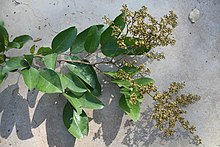Dialium guineense, the velvet tamarind,[3] is a tall, tropical, fruit-bearing tree in the family Fabaceae. It has small, typically grape-sized, edible fruits with brown, hard, inedible shells.
| Dialium guineense | |
|---|---|

| |
| Scientific classification | |
| Kingdom: | Plantae |
| Clade: | Tracheophytes |
| Clade: | Angiosperms |
| Clade: | Eudicots |
| Clade: | Rosids |
| Order: | Fabales |
| Family: | Fabaceae |
| Genus: | Dialium |
| Species: | D. guineense
|
| Binomial name | |
| Dialium guineense | |
| Synonyms[2] | |
| |
Distribution and habitat edit
Dialium guineense is native to West Africa, from Senegal east to the Democratic Republic of the Congo.[1] It grows in dense forests along the southern edge of the Sahel.
Uses edit
The bark and leaves have medicinal properties and are used against several diseases.[citation needed]
Fruit edit
Each fruit typically has one hard, flat, round, brown seed, typically 7-8 millimeters across and 3 millimeters thick. The seed somewhat resembles a watermelon seed (Citrullus lanatus). Some have two seeds. The seeds are shiny, coated with a thin layer of starch.
The pulp is edible and may be eaten raw or soaked in water and consumed as a beverage. The bitter leaves are ingredients in a Ghanaian dish called domoda.
Timber edit
Wood is hard and heavy and used for construction. The wood is also used for firewood and charcoal production
References edit
- ^ a b IUCN SSC Global Tree Specialist Group & Botanic Gardens Conservation International (BGCI) (2022). "Dialium guineense". IUCN Red List of Threatened Species. 2022: e.T204813231A204813233. Retrieved 16 January 2023.
- ^ a b "Dialium guineense". Plants of the World Online. Royal Botanic Gardens, Kew. Retrieved 22 April 2024.
- ^ "Dialium guineense". European and Mediterranean Plant Protection Organization (EPPO). Retrieved 22 April 2024.
External links edit
- World Agroforestry
- Dressler, S.; Schmidt, M. & Zizka, G. (2014). "Dialium guineense". African plants – a Photo Guide. Frankfurt/Main: Forschungsinstitut Senckenberg.
- Media related to Dialium guineense at Wikimedia Commons
- Data related to Dialium guineense at Wikispecies
